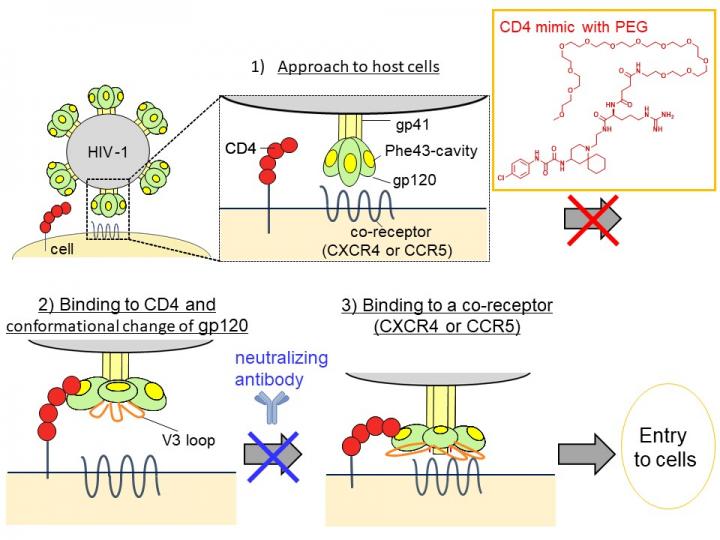
Credit: Department of Medicinal Chemistry, TMDU
Tokyo, Japan – A team of scientists led by the Institute of Biomaterials and Bioengineering at Tokyo Medical and Dental University (TMDU) have created novel molecules that prevent human immunodeficiency virus (HIV) particles from attacking immune cells. This is accomplished by injecting compounds mimicking the protein the virus usually uses to enter the cells. This work may lead to new treatments for HIV that may be more effective at stopping the proliferation of the virus with fewer side effects.
HIV is a very dangerous pathogen because it attacks the very immune cells, including T helper cells, that are needed for the body to fight back. An HIV particle first gains entrance to a T helper cell by attaching to a CD4 protein on its surface. Once inside, the reproduction machinery of the T helper cell is hijacked to make copies of HIV, ultimately killing the host cell. Many treatments, such as antiretroviral drugs, attempt to block this reproduction process, but finding a way to prevent the HIV from attaching in the first place would be a better approach.
Now, a team of researchers led by Tokyo Medical and Dental University (TMDU) created a new family of molecules that act as decoy CD4 proteins. The HIV particles preferentially attach with the fake molecules, instead of those at the surface of a cell. The scientists found that adding a polyethylene glycol (PEG) improved the pharmacokinetics. “Hybrid molecules that mimic CD4 and also have a PEG unit attached with an uncleavable linker showed better anti-HIV activity with lower cytotoxicity,” first author Takuya Kobayakawa says.
Computer simulations run by the team supported the hypothesis that the hybrid molecule works better because it can interact electrostatically with a carboxylate group on the virus. In tests with a rhesus macaque, the hybrid molecule remained in the system longer compared with the parent compound. “These CD4 mimics have strong synergistic interactions with neutralizing antibodies for fighting HIV,” senior author Hirokazu Tamamura says. New combined treatment protocols may be developed to help take advantage of the new molecules. The work is published in the Journal of Medicinal Chemistry as “Hybrids of Small-Molecule CD4 Mimics with Polyethylene Glycol Units as HIV Entry Inhibitors.” (DOI:10.1021/acs.jmedchem.0c01153).
###
Media Contact
Hirokazu TAMAMURA
[email protected]
Original Source
https:/
Related Journal Article
http://dx.




